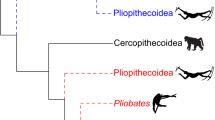Abstract
Paleontologists are interested in the “morphological origin” of anthropoids since virtually all other types of biological information are lost to us. We seek to document the series of anatomical transformations that begin with stem prosimians and end with extant higher primates. Thus, we peer into the fossil record and hope to identify transitional forms that have both prosimian and anthropoid characteristics. Primatologists have identified many postcranial features that distinguish prosimian from anthropoid primates (Table 1; e.g., Ciochon and Chiarelli, 1980; Dagosto, 1990; Fleagle, 1999; Fleagle and Kay, 1994; Kay et al., 1997; LeGros Clark, 1959). If only extant primates are considered, there is a large morphological gap between prosimian and anthropoid morphologies (Table 1). This situation begs two questions: (1) Where are the transitional forms that document the origin of anthropoids? (2) What types of primates will be considered “early,” “stem” or “basal” anthropoids? The first question is rather difficult since we need to actually find the transitional specimens while the second is simply a matter of definition.
Access this chapter
Tax calculation will be finalised at checkout
Purchases are for personal use only
Preview
Unable to display preview. Download preview PDF.
Similar content being viewed by others
References
Beard, K. C., Dawson, M. R., Wang, B., and Li, C., 1994, A diverse new primate fauna from middle Eocene fissure-fillings in southeastern China, Nature 368:604–609.
Ciochon, R. L., and Chiarelli, A. B., 1980, Evolutionary Biology of New World Monkeys and Continental Drift, Plenum Press, New York.
Conroy, G., 1976, Primate postcranial remains from the Oligocene of Egypt, Contrib. Primatol. 8:1–134.
Dagosto, M. D., 1990, Models for the origin of the anthropoid postcranium, J. Hum. Evol. 19:121–140.
Fleagle, J. G., 1999, Primate Adaptation and Evolution, Second edition, Academic Press, New York.
Fleagle, J. G., and Kay, R. F., 1987, The phyletic position of the Parapithecidae, J. Hum. Evol. 16:483–532.
Fleagle, J. G., and Kay, R. F., 1994, Anthropoid Origins, Plenum Press, New York.
Fleagle, J. G., and Simons, E. L., 1995, Limb skeleton and locomotor adaptations of Apidium phiomense, an Oligocene anthropoid from Egypt, Am. J. Phys. Anthropol. 97:235–290.
Ford, S. M., 1994, Primitive Platyrrhines? Perspective on Anthropoid Origins from Platyrrhine, Parapithecids, and Preanthropoid Postcrania, in: Anthropoid Origins, J. G. Fleagle, and R F. Kay, eds., Plenum Press, New York, pp. 595–674.
Gebo, D. L., 1993, Postcranial anatomy and Locomotor Adaptation in Early African Anthropoids, in: Postcranial Adaptation in Nonhuman Primates, D. L. Gebo, ed., Northern Illinois University Press, DeKalb, pp. 220–234.
Gebo, D. L., Dagosto, M., Beard, K. C., and Qi, T., 2001, Middle Eocene primate tarsals from China: Implications for haplorhine evolution, Am. J. Phys. Anthropol. 116:83–107.
Gebo, D. L., Dagosto, M., Beard, K. C., Qi, T., and Wang, J., 2000, The oldest known anthropoid postcranial fossils and their bearing on the early evolution of higher primates, Nature 404:276–278.
Gebo, D. L., and Simons, E. L., 1987, Morphology and locomotor adaptations of the foot in early Oligocene anthropoids, Am. J. Phys. Anthrop. 74:83–101.
Gebo, D. L., Simons, E. L., Rasmussen, D. T., and Dagosto, M., 1994, Eocene Anthropoid Postcrania from the Fayum, Egypt, in: Anthropoid Origins, J. G. Fleagle, and R. F. Kay, eds., Plenum Press, New York, pp. 203–233.
Harrison, T., 1987, The phylogenetic relationships of the early catarrhine primates: A review of the current evidence, J. Hum. Evol. 16: 41–80.
Kay, R F., Ross, C., and Williams, B. A., 1997, Anthropoid origins. Science 275: 797–804.
Kleiber, M., 1961, The Eire of Life, Wiley, New York.
LeGros Clark, W. E., 1959, The Antecedents of Man, Edinburgh University Press, Edinburgh.
McNab, B. K., 1980, Food habits, energetics, and the population biology of mammals, Am. Nat. 116:106–124.
Simons, E. L., 1990, Discovery of the oldest known anthropoidean skull from the Paleogene of Egypt, Science 247:1567–1569.
Simons, E. L., 1995, Skulls and anterior teeth of Catopithecus (Primates: Anthropoidea) from the Eocene and anthropoid origins, Science 268:1885–1888.
Simons, E. L., 1997, Preliminary description of the cranium of Proteopithecus sylviae, an Egyptian late Eocene anthropoidean primate, Proc. Natl. Acad. Sci. USA 94:14970–14975.
Simons, E. L., 2001, The cranium of Parapithecus grangeri, an Egyptian Oligocene anthropoidean primate, Proc. Natl. Acad. Sci. USA 98:7892–7897.
Simons, E. L., and Seiffert, E. R, 1999, A partial skeleton of Proteopithecus sylviae (Primates, Anthropoidea): First associated dental and postcranial remains of an Eocene anthropoidean, C.R. Acad. Sci. 11. 329:921–927.
Soini, P., 1988, The Pygmy Marmoset, Genus Cebuella, in: Ecology and Behavior of Neotropical Primates, vol. 2, R. Mittermeier, A. B. Rylands, A. F. Coimbra-Filho, and G. A. B. Fonseca, eds., World Wildlife Fund, Washington, D. C., pp. 223–298.
Williams, B. A., and Kay, R. F., 1994, The taxon Anthropoidea and the crown clade concept. Evol. Anth. 3:188–190.
Yoder, A. D., Rasoloarison, R. M., Goodman, S. M., Irwin, J. A., Atsalis, S., Ravosa, M. J., and Ganzhorn, J. J., 2000, Remarkable species diversity in Malagasy mouse lemurs (primates, Microcebus), Proc. Natl. Acad. Sci. USA 97:11325–11330.
Author information
Authors and Affiliations
Editor information
Editors and Affiliations
Rights and permissions
Copyright information
© 2004 Springer Science+Business Media New York
About this chapter
Cite this chapter
Gebo, D.L., Dagosto, M. (2004). Anthropoid Origins: Postcranial Evidence from the Eocene of Asia. In: Ross, C.F., Kay, R.F. (eds) Anthropoid Origins. Developments in Primatology: Progress and Prospects. Springer, Boston, MA. https://doi.org/10.1007/978-1-4419-8873-7_15
Download citation
DOI: https://doi.org/10.1007/978-1-4419-8873-7_15
Publisher Name: Springer, Boston, MA
Print ISBN: 978-1-4613-4700-2
Online ISBN: 978-1-4419-8873-7
eBook Packages: Springer Book Archive




